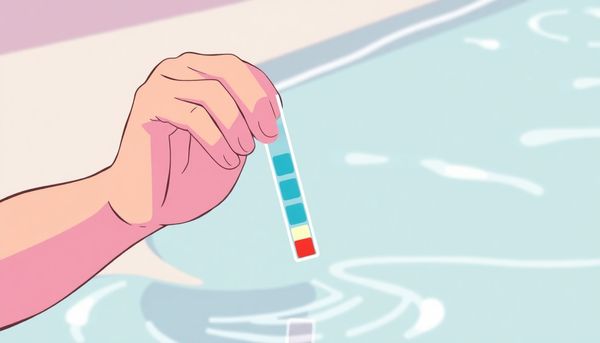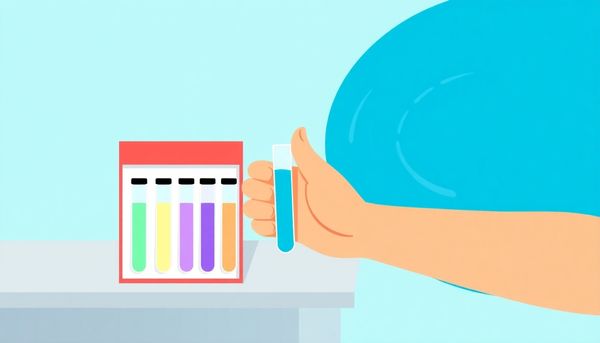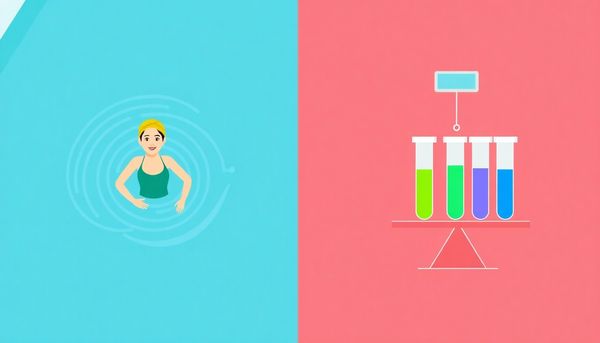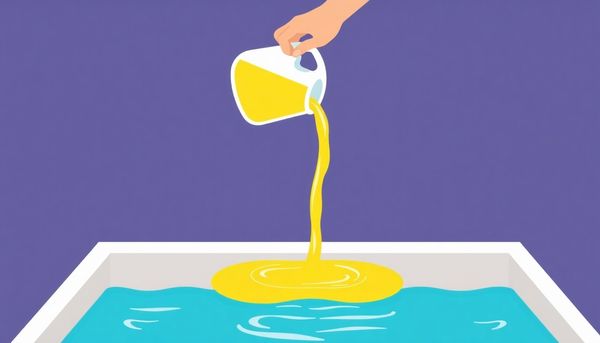Master Pool Maintenance: Achieve Perfect Chlorine Balance
November 30th, 2024
November 30th, 2024
Opening the gate to your backyard oasis, you’re greeted by the shimmering blue of your pool, a tempting retreat on a hot day. But before you jump in, there's an invisible yet crucial task at hand: balancing the chlorine levels. Chlorine, the unsung hero of the pool world, works tirelessly to keep your aquatic haven free from harmful bacteria and algae. Without it, your pool could quickly transform from a refreshing escape to a breeding ground for unwanted guests.
I remember the first time I dealt with pool maintenance. The chemistry set-like assortment of test strips and bottles sprawled across the deck seemed daunting. My neighbor, a seasoned pool owner, explained that chlorine’s role is akin to that of a vigilant lifeguard, ensuring the water remains safe and inviting. Yet, the amount needed isn’t a one-size-fits-all solution. It depends on various factors, including pool size, water temperature, and frequency of use.
Understanding the intricacies of chlorine dosage might feel overwhelming at first, but it's a vital skill for any pool owner. The balancing act involves more than just dumping in chemicals. It’s about achieving that sweet spot where the water is clean, yet gentle on the skin and eyes. With a little knowledge and routine, maintaining this balance becomes second nature, allowing you to enjoy your pool with peace of mind and confidence.

Understanding the precise chlorine needs of your pool is akin to crafting the perfect cup of coffee: the right balance transforms everything. Chlorine is pivotal in maintaining the purity and safety of your pool water, but determining the exact amount requires a bit of calculation and observation.
Start by acknowledging the parameters: your pool's size, the current chlorine level, and the type of chlorine you prefer. For a standard-sized pool, a few tablets or a measured cup of granules might suffice, but this changes with varying pool capacities and chlorine forms. Tablets offer convenience but can be tricky to manage in terms of dissolve rate, especially in fluctuating temperatures. Conversely, liquid chlorine is potent and straightforward but demands additional stabilizers to remain effective under sunlight.
Regular testing is your best ally. Monitoring chlorine levels weekly helps you stay ahead of any potential dips or spikes. A reliable test kit or strips will guide you in maintaining the ideal free chlorine range of 1 to 3 ppm, with 3 ppm being optimum. Yet, be mindful of factors such as heavy rainfall, frequent pool parties, and debris, all of which can swiftly alter chlorine levels.
Remember, balancing pH and alkalinity before adding chlorine enhances its efficacy. Maintaining a healthy cycle of testing, adjusting, and occasionally shocking ensures that your pool remains a sparkling oasis, ready for any swimmer at any time.
Selecting the right type of chlorine for your pool is like choosing the perfect tool for a job—each has its own strengths and best use scenarios. When I first started managing my pool, the options seemed overwhelming, but understanding each type made all the difference. Granules, for instance, offer precision. They allow you to sprinkle the exact amount needed right over the water, providing direct control over the dosage. This form is stabilized with cyanuric acid (CYA), which shields chlorine from the sun's rays, a feature particularly valuable in sunny climates.
On the other hand, tablets are the convenient route. These trichlor pucks fit neatly into a floater or automatic chlorinator, releasing chlorine gradually. In cooler weather, I found tablets to be a lifesaver when maintaining consistent chlorine levels without daily attention. However, they can lead to an increase in CYA over time, so regular monitoring is essential.
Then there's liquid chlorine, reminiscent of a quick fix. While less potent than its counterparts, it’s ideal for giving a rapid chlorine boost without worrying about CYA build-up, as it lacks stabilizers. This unstabilized form requires the addition of a separate stabilizer if your pool gets a lot of sun exposure.
Ultimately, the choice boils down to your pool's specific needs and your maintenance style. Whether it's the hands-on approach with granules or the ease of tablets, knowing your options allows you to maintain crystal-clear, safe waters with confidence.
Before diving into the world of chlorine, there's a critical step that can't be overlooked: testing and balancing your pool chemistry. This isn't just about maintaining a crystal-clear oasis; it’s about ensuring your pool water is safe and comfortable for swimmers. Start with a reliable testing method—test strips offer a quick snapshot, but for precision, a liquid test kit is your best ally. These tests will cover essential parameters like total alkalinity, pH, and cyanuric acid levels, providing a comprehensive overview of water health.
When your pool’s pH and alkalinity are off, chlorine can become less effective. A pool with unbalanced levels will consume chlorine more rapidly, leading to frequent, unnecessary additions and potentially cloudy or unsafe water. The key is to get these parameters in check first. Aim for a pH between 7.2 and 7.6 and total alkalinity between 80 and 120 ppm. This range allows chlorine to perform optimally, disinfecting your pool efficiently.
Once your water chemistry is stable, focus on maintaining free chlorine levels between 1 and 3 ppm, with 3 ppm as the sweet spot. Remember, external factors like sun exposure, pool usage, and unexpected rain can impact these levels. Regular testing, ideally weekly, will help you catch fluctuations early. By understanding your pool's unique needs, you can apply chlorine accurately, ensuring a sparkling, inviting pool all season long.
Maintaining the right chlorine balance in your pool is akin to keeping a perfect harmony in an orchestra. Each element must play its part for the symphony to sound right, and chlorine is no different. This chemical warrior defends against harmful bacteria and algae, but it needs to be managed with care. To safely adjust chlorine levels, begin with a clear understanding of your pool's unique requirements. Is your pool modestly sized or a backyard behemoth? Each demands a tailored approach to chlorine dosing—whether through granules, tablets, or liquid options.
Let's say you prefer the convenience of tablets. These seemingly benign pucks pack a punch, steadily dissolving to maintain your pool's defenses. However, keep an eye on cyanuric acid levels, as these can build up when using stabilized chlorine forms, potentially undermining your efforts. On the other hand, if your style leans towards granules or liquid chlorine, remember they might need a little more of your attention. Granules require a measured hand for broadcasting, while liquid chlorine’s potency can be fleeting under direct sunlight without stabilization.
Before any chlorine addition, test your water's pH and alkalinity. This ensures that your chlorine can perform at its best. Use straightforward test strips or opt for a liquid test kit for heightened precision. Always ensure your pool’s pump and filter are actively circulating to evenly distribute the chlorine throughout the water. If an accidental overdose occurs, patience is your ally. Chlorine levels usually drop naturally, but a swift adjustment with fresh water or a neutralizer can help speed things along. Embrace these steps and your pool will be a sparkling oasis, welcoming and safe for all who take the plunge.

Selecting the right chlorine for your pool is akin to choosing the perfect seasoning for a dish — it's essential for balance and flavor, or in this case, water quality. Each type of chlorine — granules, tablets, or liquid — has its own personality, and understanding these differences can make pool maintenance less daunting.
Granular chlorine, often made of dichlor, is the DIY enthusiast's choice. It's similar to sprinkling salt over your favorite meal: you control the dose, and it dissolves quickly. Yet, like a scatter of salt, it requires a steady hand; too little and it’s ineffective, too much and you risk overkill. Its stability under sunlight, thanks to cyanuric acid, makes it a reliable friend in sunny climates.
On the other hand, chlorine tablets are the set-it-and-forget-it option. Toss a few trichlor tablets into a floater or chlorinator, and let them do their magic. However, the ease comes with a caveat: the rate of dissolution can be unpredictable, influenced by water temperature and flow. This can lead to an unexpected buildup of cyanuric acid, so regular monitoring is crucial.
Liquid chlorine, the minimalistic approach, offers quick dispersal and potent cleaning with its 10-12% concentration. But, like the sun-kissed skin at risk of burning, it needs protection from UV rays, lacking built-in stabilizers. Adding your own cyanuric acid ensures it stays effective longer.
Choosing the right chlorine is a balance of convenience, control, and environmental conditions. Each type plays a vital role in keeping your pool sparkling and safe, so consider your lifestyle and pool needs before making a decision.
Understanding the right amount of chlorine for your pool is crucial for maintaining clean and safe water. Think about it like seasoning a dish; too little, and it's bland, too much, and it’s overpowering. The key to getting it right lies in understanding your pool’s specific needs, starting with its volume. Whether your aquatic haven is a modest plunge or a sprawling oasis, knowing the size is step one in effective chlorine management.
Once you grasp the volume, consider the type of chlorine you're using. Granules, tablets, and liquid each have their quirks. Granules offer control with manual dosing, while tablets provide convenience but require careful monitoring due to potential cyanuric acid buildup. Liquid chlorine, on the other hand, is potent yet lacks stabilization, demanding a stabilizer to protect it from sunlight.
Before adding chlorine, ensure your pool’s pH and alkalinity levels are balanced. A simple test strip can quickly point out areas needing adjustment. The goal is to keep your free chlorine levels between 1 and 3 parts per million (PPM), with 3 PPM being the sweet spot for most pools. If levels fall drastically, a shock treatment might be necessary to reset the balance. Conversely, if levels are too high, halt chlorine additions and let them naturally decrease, or introduce fresh water for quicker dilution.
Remember, routine testing and adjustments are your best allies in pool maintenance. By staying vigilant, you can enjoy crystal-clear waters all season long.
Choosing the right form of chlorine for your pool can feel a bit like picking the perfect outfit for an unpredictable day. Each type—granules, tablets, or liquid—offers distinct benefits and challenges, akin to choosing between a sweater, a raincoat, or a t-shirt based on your needs. Granules, often made of dichlor, are the choice for those who enjoy having precise control. They require manual addition, scattering them like confetti across the pool’s surface. Their advantage lies in their stabilization with cyanuric acid, protecting them from the sun's harsh breakdown effects.
On the other hand, tablets, usually composed of trichlor, provide a more hands-off approach. These are the slow-release option, fitting conveniently into floaters or automatic chlorinators. Yet, like a lazy river, they dissolve at their own pace, influenced by factors like temperature and circulation. Their ease, however, comes with a caveat—monitoring cyanuric acid levels closely to prevent buildup.
Lastly, liquid chlorine swoops in as the straightforward hero for those who appreciate simplicity. Unstabilized and potent, it needs no fancy gadgets—just a steady hand to pour. But beware, its lack of stabilizers means it fades rapidly under the sun without a little help from added cyanuric acid. Balancing these forms with your pool’s unique demands ensures a sparkling, inviting oasis ready for any spontaneous splash.
Balancing your pool's water chemistry is akin to mastering a delicate dance. Each step is crucial to ensure that the chlorine remains effective and your pool stays inviting. Start by testing the water regularly—weekends are a good time since it becomes part of a routine. Using test strips or a liquid kit, check the levels of free chlorine, pH, alkalinity, and cyanuric acid. Each parameter plays a key role; for example, if your pH or alkalinity is off, chlorine's ability to sanitize can be severely compromised.
Once, I faced a puzzling decline in chlorine levels despite regular dosing. A quick test revealed high pH and alkalinity. Lowering these to the recommended ranges (pH between 7.2 and 7.6 and alkalinity between 80 and 120 ppm) restored balance, allowing the chlorine to do its job efficiently.
It's essential to maintain this balance consistently. Extreme fluctuations—caused by heavy rain or a pool party—can swiftly disrupt water chemistry. That's why establishing a regular maintenance schedule is vital. Keep an eye on the cyanuric acid, especially when using stabilized chlorine, as it can accumulate over time and reduce chlorine's effectiveness.
Whether it's a scorching summer day or a tranquil autumn afternoon, regularly testing and adjusting ensures your pool remains a safe haven for leisure. This routine not only simplifies pool upkeep but also extends the life of your water quality, creating a consistently pleasant swimming environment.

Testing the water is the fundamental first step before adding any chlorine to your pool. Without this crucial step, you’re essentially guessing how much chlorine is needed, which can lead to ineffective sanitation or, worse, over-chlorination. One summer, a friend of mine skipped this step, thinking his pool looked clear enough. Unfortunately, that oversight led to a green surprise after a week of neglect. Testing the water helps you avoid such missteps and ensures your swimming environment remains safe and inviting.
Various elements can affect chlorine levels, including debris, weather, and pool usage. Thus, testing is not a one-time activity but a routine that should be part of your pool maintenance schedule. Using test strips is a quick way to gauge your pool's health, measuring key factors like pH, alkalinity, and free chlorine levels. For more precise measurements, a liquid test kit can offer detailed insights.
Understanding your pool’s current state guides you on the appropriate chlorine dosage. Too little chlorine, and you risk bacterial growth; too much, and the water becomes harsh on skin and eyes. By consistently checking your water’s chemistry, you gain control over chlorine management, tailoring treatments to fit the particular needs of your pool at any given time. This meticulous approach not only preserves the clarity of your water but also extends the life of your pool equipment.
Selecting the appropriate chlorine type for your pool is akin to choosing the right tool for a project—each option presents distinct advantages tailored to various needs. For instance, granular chlorine, often favored for its manual dosing precision, grants pool owners direct control over their sanitizing routine. Resembling tiny snowflakes, these granules disperse swiftly across the water’s surface, allowing for a precise and immediate boost in chlorine levels. Their stabilizing property—thanks to cyanuric acid—also acts like sunscreen for chlorine, protecting it from the degrading effects of sunlight.
On the other hand, chlorine tablets offer a more leisurely approach to maintenance. These solid discs dissolve gradually, ensuring a steady, consistent chlorine release over time. While they take a bit longer to integrate into your water, they are quite convenient. However, it's essential to monitor the cyanuric acid levels they contribute, as an excess can inhibit chlorine efficiency.
Lastly, liquid chlorine stands as a quick fix, ideal for fast results. Despite its potency being less than other forms, its ease of use makes it perfect for immediate adjustments when chlorine levels plummet. However, as it lacks stabilization, pairing with a stabilizer is necessary to prevent rapid degradation under the sun.
Each chlorine type has its own rhythm and role. Understanding your pool’s unique needs, alongside how often you interact with it, will guide you in choosing the right chlorine companion.
As any pool owner will tell you, maintaining the right balance in your pool water is a bit like keeping harmony in a small ecosystem. Each element plays a vital role, and sometimes, it just takes a little nudge to keep everything working smoothly. Your first step in this watery dance is to test your pool water regularly. Whether you're using test strips or a more detailed liquid test kit, it's crucial to check not just the chlorine levels but also the pH, alkalinity, and other key chemical balances.
Once you've dipped your toes into testing, you'll want to ensure your pH and alkalinity are in check. This isn't just a tedious chore; it's the secret sauce that allows your chlorine to work its magic. Think of it like setting the stage for a perfect performance. A balanced pH ensures that chlorine can effectively sanitize the water without being hindered by chemical imbalances. For those who prefer a more hands-on approach, liquid test kits offer precision and detail, giving you an even clearer picture of your pool's condition.
After ensuring your water is primed, knowing your pool's volume is key to administering the right amount of chlorine. With pumps and filters running, your pool transforms into a well-oiled machine, circulating and dissolving the chlorine efficiently. This method ensures that every splash remains safe and refreshing. When it comes to keeping your pool ready for summer fun, testing and balancing might just be your best allies.
Understanding the art of maintaining the perfect chlorine balance in your pool can transform your swimming experience. It's not merely about pouring chemicals into water; it’s about creating a safe, inviting space to swim. Think of chlorine as your pool's personal bodyguard, standing firm against bacteria and algae. Aim for a free chlorine level between 1 and 3 PPM, with 3 PPM being the sweet spot. Yet, factors like debris, rain, and even the beaming sun can cause these levels to waver unexpectedly.
Every pool owner knows the frustration of fluctuating chlorine levels. Regular testing, ideally weekly, is your ticket to consistency. A simple test strip or a more detailed liquid kit can reveal your water's secrets. Once you have the readings, adjust accordingly. Choose between granules, tablets, or liquid chlorine—and remember, each has its quirks. Granules offer precision, tablets provide convenience, and liquid works swiftly but requires stabilization against sunlight.
A personal tip: before you dive into the world of chlorine additions, ensure your pool’s pH and alkalinity are balanced. This foundational step amplifies chlorine's effectiveness, making your maintenance efforts worthwhile. If your levels consistently fall short, consider a shock treatment to reset the balance. Over time, with practice and patience, maintaining the ideal chlorine level becomes second nature, ensuring your pool remains a crystal-clear haven for all to enjoy.

Maintaining the delicate balance of chemicals in your pool is akin to conducting a symphony. Each element plays an integral role, and when in harmony, they create the perfect aquatic environment. Among these components, chlorine serves as a vigilant guardian, warding off harmful bacteria and keeping the water pristine. However, chlorine is not a lone warrior; it depends on other parameters to perform effectively.
Start by examining your pool's pH and alkalinity. These are the foundation upon which chlorine builds its defenses. A pH level between 7.2 and 7.8 is essential; too high or too low can render chlorine less effective, just like trying to whistle while chewing gum. Alkalinity should nestle comfortably between 80 and 120 ppm, acting as a buffer to prevent drastic pH shifts.
Once these levels are confirmed, the spotlight returns to chlorine. Testing for free and total chlorine levels reveals how much of this sanitizer is actively battling contaminants. While testing strips provide a quick overview, liquid test kits offer a more precise analysis, akin to using a magnifying glass instead of squinting.
If your chlorine levels waver despite your best efforts, investigate further. High cyanuric acid, which stabilizes chlorine but can also inhibit its effectiveness if too concentrated, may be to blame. Addressing these chemical subtleties ensures your pool remains a crystal-clear oasis. With balance achieved, your pool is not just a body of water but a well-tuned masterpiece of chemical harmony.
Chlorine, the unsung hero of pool party bliss, comes in a variety of forms, each with its own quirks. Granules, tablets, or liquid—all promise to keep your swimming haven clean, but choosing the right type depends on your lifestyle and pool habits. Granules offer a hands-on approach, perfect for those who enjoy having a direct influence on their pool's chemistry. You sprinkle them over the water, like seasoning a favorite dish, giving you the power to fine-tune chlorination. Plus, they come with the bonus of stabilization, thanks to the cyanuric acid they contain, safeguarding your chlorine from the relentless sun.
If convenience is king for you, tablets might be the way to go. These trichlor powerhouses can be tossed into a floater or an automatic feeder, taking over your chlorine duties as you relax poolside. However, keep in mind they can dissolve unpredictably, influenced by water temperature or pump activity. Tablets also contribute to rising cyanuric acid levels, which requires consistent monitoring.
For those who prefer the no-fuss approach, liquid chlorine presents itself as a straightforward solution. Unstabilized and potent, it demands a bit of extra attention to prevent sunlight from zapping its effectiveness. A little cyanuric acid boost will do the trick. Ultimately, understanding these options helps tailor your pool maintenance to fit your needs, ensuring crystal clear waters greet every splash.
A blissful afternoon by the pool can quickly turn frustrating if the water chemistry isn’t cooperating. pH levels play a crucial role in this delicate ecosystem, influencing the efficacy of chlorine. Without proper balance, even a well-calculated chlorine dose won't work effectively. Years ago, during my initial foray into pool maintenance, I learned the hard way that ignoring pH can lead to cloudy water and irritated eyes, regardless of chlorine levels.
Begin by testing your water’s pH using reliable test strips or a liquid test kit. Ideally, the pH should fall between 7.2 and 7.6. Anything below this range can cause chlorine to dissipate too quickly, while higher levels might lead to scaling and ineffective sanitation. I discovered that adjusting pH first ensures that every bit of chlorine you add does its job effectively. It’s like setting the stage for a star performer.
Once you have your pH in check, make gradual adjustments using pH increaser or decreaser, as needed. Remember, altering pH is a bit like adding spices to a dish; too much, too fast, can ruin the balance. Keep an eye on total alkalinity as well, which acts as a buffer, preventing drastic pH swings. This attention to detail can save you time and headache, helping maintain that crystal-clear oasis.
Crafting a chlorine dosing strategy for your pool is like mastering a delicate balance where chemistry meets relaxation. With the right approach, you'll be able to maintain pristine water without the constant guesswork. Start by understanding your pool's unique needs: its volume, typical bather load, and environmental factors like sunlight exposure all play a role. Once you've got a handle on these variables, you'll be equipped to decide whether granules, tablets, or liquid chlorine will serve you best.
Granules offer flexibility, allowing you to sprinkle just the right amount across the pool's surface, while stabilizing agents in tablets give a more hands-off approach, albeit with the risk of cyanuric acid buildup. Liquid chlorine, on the other hand, is straightforward and potent but lacks stability under the sun without additional treatment.
Test your pool water weekly using either strips or a liquid kit to ensure your free chlorine levels remain between 1 and 3 PPM, ideally hitting the sweet spot at 3 PPM. Before dosing, always adjust pH and alkalinity, as these factors significantly influence chlorine’s effectiveness. Running the pool pump during this process ensures even distribution of the chemical.
If you find your levels frequently bottom out or spike, it may be time to shock the pool—a concentrated blast of chlorine to reset your water chemistry. Remember, consistency is your ally in this chlorine balancing act, ensuring your pool remains a sanctuary of clear, inviting water.

Ensuring your pool stays pristine sometimes requires a little extra effort, especially when your chlorine levels consistently waver. This is where shocking your pool comes into play—a powerful method to reset and maintain the water's clarity and safety. Before you start, understanding the basics is crucial. Shocking a pool means adding a hefty dose of chlorine to obliterate contaminants and restore the ideal chlorine level. But how do you do this safely without transforming your backyard oasis into a chemical soup?
First, ensure your pool’s pH is balanced. Chlorine is most effective when your water's pH is between 7.2 and 7.6. Once balanced, calculate the necessary amount of shock product based on your pool’s volume and current chlorine level. If your pool holds 20,000 gallons and your free chlorine is at zero, you might need around 2 pounds of shock for a healthy boost.
Remember to dissolve granular shock in a bucket of water before introducing it to your pool—never add it directly. This pre-mixing prevents granules from settling on the pool floor and potentially staining or damaging surfaces. With your pool pump running, evenly distribute the solution across the water's surface. Ideally, shock your pool in the evening to allow it to work overnight undisturbed by sunlight, which can degrade chlorine.
By following these steps, you not only safeguard your pool's health but also ensure a safe swimming environment for family and friends.
Understanding how much chlorine to add to your pool is much like fine-tuning a musical instrument. It requires attention to detail, periodic adjustments, and an understanding of the variables at play. The first step to determining chlorine requirements is measuring your pool’s volume. Knowing the precise capacity helps tailor the chlorine dose, ensuring you maintain that ideal 1 to 3 parts per million (PPM) range.
Once the volume is established, the next consideration is the type of chlorine you prefer: granules, tablets, or liquid. Each form offers unique benefits and challenges. Granules grant you the flexibility of precise dosing, while tablets offer convenience in a dispenser. On the other hand, liquid chlorine, though less concentrated, can provide a quick boost but requires stabilization under the sun’s rays.
Regularly testing your pool's water cannot be overstressed. This is where the science of pool maintenance turns into an art. A test strip or liquid test kit will provide insights beyond just chlorine levels—pH, alkalinity, and cyanuric acid play critical roles. Balancing these elements first ensures chlorine performs more efficiently.
Keep an eye on environmental factors: rain, increased swimming activity, and sunlight can rapidly alter chlorine levels. If levels drop unexpectedly, it may be time for a shock treatment to restore balance. Remember, pool care is a dynamic process requiring a vigilant eye and a proactive approach, ensuring your aquatic oasis remains clear and inviting.
Selecting the right type of chlorine for your pool is like choosing the right tool for a job; each option has its unique advantages and suits different maintenance styles. Granules, for instance, offer flexibility. I remember when I first started managing my pool, granules were my go-to. Sprinkling them allowed me to adjust dosages weekly based on how lively our pool gatherings were, ensuring I had precise control. Their stabilized nature, thanks to the cyanuric acid content, meant they stayed effective longer under the sun’s intense rays.
On the other hand, chlorine tablets are the epitome of convenience. These were my saviors during busy weeks when manual dosing wasn’t feasible. Simply placing them in a floater or automatic chlorinator meant less hands-on work, though I had to watch the cyanuric acid levels to prevent buildup. Tablets do dissolve at varied rates depending on water conditions, which adds a layer of unpredictability but offers peace of mind for those who prefer a set-and-forget approach.
For those who prefer an instant fix, liquid chlorine is the powerhouse. It’s akin to a fast-acting remedy for sudden chlorine dips. However, since it lacks stabilizers, additional cyanuric acid is often needed to prolong its effectiveness under sunlight. This makes it an ideal choice for quick adjustments, especially after a heavy rain or a pool party. Choosing the appropriate chlorine type ultimately depends on how hands-on you want to be and the specific needs of your pool’s environment.

This article provided insights into maintaining your pool. Start your pool care journey today!
Want to become a pool maintenance expert? Our free Pool School course covers everything you need to know about pool care. From basic maintenance to advanced troubleshooting, you'll learn how to:
Join over 10,000 pool owners who have already transformed their pool care routine. Get started with our free Pool School course today!